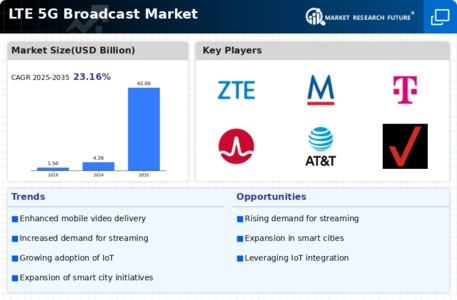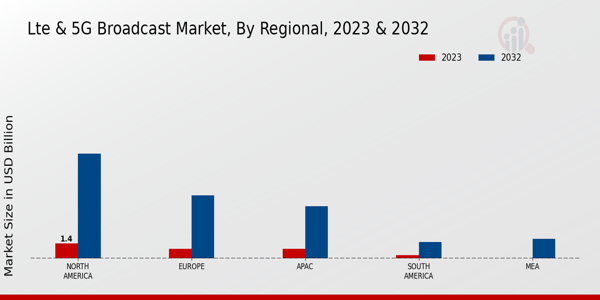Emergence of Smart Devices
The proliferation of smart devices is a key driver for the LTE 5G Broadcast Market. With the increasing adoption of smartphones, tablets, and smart TVs, consumers are demanding more interactive and engaging content. This trend is reflected in the growing number of connected devices, which is expected to reach 30 billion by 2025. As these devices become more prevalent, the need for efficient broadcasting solutions that can deliver content seamlessly across various platforms becomes critical. The LTE 5G Broadcast Market is poised to leverage this trend by providing tailored broadcasting solutions that cater to the unique requirements of smart devices, thereby enhancing user experience and engagement.
Regulatory Support and Standardization
Regulatory support and standardization are crucial factors driving the LTE 5G Broadcast Market. Governments and regulatory bodies are increasingly recognizing the potential of 5G technology to enhance communication and broadcasting services. Initiatives aimed at establishing standards for 5G broadcasting are being developed, which could facilitate smoother implementation and adoption of these technologies. For instance, the establishment of clear guidelines for spectrum allocation and usage is expected to promote investment in LTE 5G infrastructure. This regulatory environment is likely to encourage more players to enter the LTE 5G Broadcast Market, fostering competition and innovation, ultimately benefiting consumers with improved broadcasting services.
Adoption of Augmented and Virtual Reality
The LTE 5G Broadcast Market is likely to benefit from the increasing adoption of augmented reality (AR) and virtual reality (VR) technologies. These immersive technologies require high bandwidth and low latency for optimal performance, which LTE 5G can provide. As industries such as gaming, education, and entertainment explore AR and VR applications, the demand for reliable broadcasting solutions is expected to rise. Market analysts suggest that the AR and VR market could reach USD 200 billion by 2025, indicating a substantial opportunity for the LTE 5G Broadcast Market to integrate these technologies into their offerings. This integration could enhance content delivery and create new revenue streams for broadcasters.
Expansion of Mobile Network Infrastructure
The LTE 5G Broadcast Market is significantly influenced by the ongoing expansion of mobile network infrastructure. Telecommunications companies are investing heavily in upgrading their networks to support 5G capabilities, which enhances the overall broadcasting experience. According to recent data, the number of 5G base stations is projected to exceed 1 million by 2025, facilitating widespread access to LTE 5G broadcast services. This infrastructure development not only improves coverage but also increases the capacity for data transmission, allowing for more efficient broadcasting. As a result, the LTE 5G Broadcast Market is likely to benefit from this enhanced network capability, enabling broadcasters to reach larger audiences with improved service quality.
Increased Demand for High-Quality Streaming
The LTE 5G Broadcast Market is experiencing a surge in demand for high-quality streaming services. As consumers increasingly seek seamless and high-definition content, the need for robust broadcasting solutions becomes paramount. This trend is evidenced by the projected growth rate of the market, which is expected to reach USD 1.5 billion by 2026. The ability of LTE 5G technology to deliver superior video quality and low latency is driving content providers to adopt these solutions. Furthermore, the rise of over-the-top (OTT) platforms is compelling traditional broadcasters to innovate and enhance their service offerings. Consequently, the LTE 5G Broadcast Market is positioned to capitalize on this growing consumer preference for high-quality content delivery.


















Leave a Comment